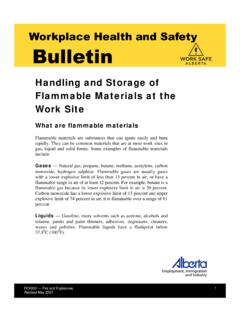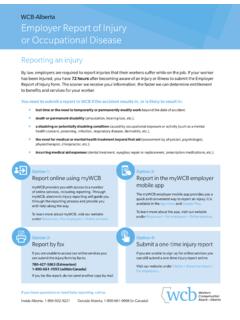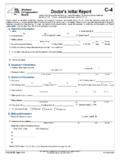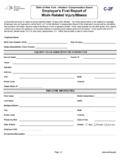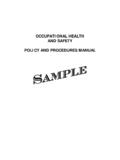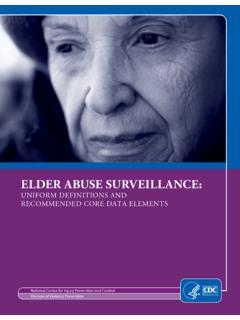Transcription of October 21, 2021 Prepared by: Sean Tucker, PhD Anya Keefe, …
1 2021 report on Work Fatality and injury Rates 1 2021 report on Work Fatality and injury Rates in Canada October 21, 2021 Prepared by: Sean Tucker, PhD Anya Keefe, MSc 2021 report on Work Fatality and injury Rates 2 Acknowledgements Thank you to Bell (University of Regina), Bob Barnetson (Athabasca University), Bruce Cielen (Workers Compensation Board of Manitoba), Jilal Jemal (Association of Workers Compensation Boards of Canada), Gabrielle Klass (Saskatchewan Workers Compensation Board), Noah Li (University of Regina), Esther Mass (University of British Columbia), Eagleclaw Thom (Regina), Barry Warrack (Workers Compensation Board of Manitoba), and Jessica Wood (Queen s University) for their assistance with this research. Special thanks to Jessica Antonini, Janelle Gerard, Lucas Mack, and Shandi Van De Sype (University of Regina) for helping to prepare past reports.
2 Correspondence concerning this report can be sent to Sean Tucker, Faculty of Business Administration, University of Regina, Regina, SK, Canada, S4S 0A2. Email: 2021 report on Work Fatality and injury Rates 3 Executive Summary Canadian workers compensation boards reported that 925 workers died due to work-related causes in 2019. This report provides a jurisdictional comparison of work-related injury and fatality rates in Canada between 2015 and 2019 using data from the Association of Workers Compensation Boards of Canada (AWCBC). A comparison of fatality rates is important for identifying trends over time both within and between provinces and territories. Job-related fatalities are classified as injury ( , death due to job-related electrocution) or occupational disease related ( , death from mesothelioma due to work-related exposure to asbestos). Important Data Limitations Several factors affect the accuracy, reliability, and jurisdictional comparability of fatality and injury rates within Canada.
3 Readers should consider several factors ( , industry mix, jurisdictional size, injury under-reporting, differences in legislation among jurisdictions) when interpreting and comparing fatality and injury rates. Comparable 2020 provincial and territorial fatality statistics will not be available through the AWCBC until early 2022. injury -Related Fatality Rate Northwest Territories and Nunavut had the highest 5-year average injury fatality rate ( deaths per 100,000). Among provinces with over 100,000 workers, Saskatchewan s 5-year average injury fatality rate ranks highest ( per 100,000) followed by Alberta ( per 100,000). Five of 12 jurisdictions experienced an increase in their 2019 injury fatality rate compared to their 2016-2018 average rate. Among jurisdictions with over 100,000 full-time equivalent employees, Newfoundland and Labrador (116%), New Brunswick (43%), and Alberta (9%) showed the greatest percentage increase in their 2019 injury fatality rate.
4 occupational Disease-Related Fatality Rate Among provinces with over 100,000 workers, Newfoundland and Labrador had the highest five year average occupational disease fatality rate ( deaths per 100,000), followed by Nova Scotia ( deaths per 100,000) and Ontario ( deaths per 100,000). In 2019, occupational disease fatality rates decreased in all but three jurisdictions. A comparison of the 2016-2018 average rates to the 2019 rates showed that among provinces with over 100,000 workers, Manitoba (20%) and British Columbia (1%) increased, while there was no change in Alberta. 2021 report on Work Fatality and injury Rates 4 Lost-Time injury Rate Among provinces with over 100,000 workers, Manitoba continues to have the highest 5-year lost-time injury rate ( per 100), followed by British Columbia ( per 100), and Saskatchewan ( per 100). In 2019, five of 12 jurisdictions reported higher injury rates.
5 A comparison of the 2016-2018 average rates to the 2019 rates showed that among provinces with 100,000 employees, Alberta (11%), New Brunswick (10%), and Quebec (9%) showed the greatest increase in lost-time injury rate. Work-Related COVID-19 Claims in 2020 In 2020, there were approximately 32,742 accepted injury claims and 39 fatality claims for work-related exposures to COVID-19. Recommendations to Address Data Limitations The following recommendations would strengthen the accuracy and comparability of the data for future analyses, as well as foster improved awareness and prevention of work-related injuries, diseases, and fatalities in Canada. 1. Release previous year s injury and fatality statistics by March 31 2. Harmonize data collection and reporting within and across jurisdictions 3. Explore creative solutions to address the problem of under-reporting 4. Enhance primary prevention activities 2021 report on Work Fatality and injury Rates 5 Table of Contents Acknowledgements.
6 2 Executive Summary .. 3 Dedication .. 6 Introduction .. 7 Methodology .. 8 Important Data Limitations .. 9 Work-Related Fatality and injury Rates by Jurisdiction, 2014-2019 .. 14 Provincial and Territorial Work-Related injury Fatality Rates .. 15 Provincial and Territorial Work-Related occupational Disease Fatality Rates .. 18 Provincial and Territorial Work-Related Lost-Time injury Rates .. 21 Provincial Work-Related Fatality and injury Rate Graphs, 2010-2019 .. 24 Provincial Work-Related Fatality Rate Graphs .. 25 Provincial Work-Related injury Rate Graphs .. 30 COVID-19 WCB Claims in 2020 .. 35 Recommendations .. 36 Selected Research and Media Reporting on Workplace Fatalities in Canada .. 39 Appendix: AWCBC Explanatory Notes (2010-2019) .. 44 2021 report on Work Fatality and injury Rates 6 Dedication To those who died because of their work Arlene Reid, age 51, a mother and grandmother, died April 2020 from COVID-19 contracted at work as a Personal Support Worker.
7 Photo from CBC News Toronto. Sharon Roberts, age 59, died April 2020 from COVID-19 contracted at work as a Personal Support Worker. Photo from CBC News Calgary. Benito Quesada, age 51, husband and father of four, died May 2020 from COVID-19 contracted at work. Photo from CBC News Calgary. Christine Mandegarian, age 54, wife and mother, died April 2020 from COVID-19 contracted at work as a Personal Support Worker. Photo from CBC News Calgary. Hiep Bui, age 67, wife, died April 2020 from COVID-19 contracted at work. Photo from CBC News Calgary. Jasvinder Riar, age 31, husband and new father, died on the job June 2020. Photo from CTV News BC. Andrew Orfanakos, age 48, husband and grandson, died on the job December 2020. Photo from Daily Commercial News. Claude Fontaine, age 58, father and brother, died on the job December 2020. Photo from CBC News North. Mike Patterson, age 55, husband, father of two children, died on the job December 2020.
8 Photo from CTV News Ottawa. John Martens, age 21, boyfriend and brother to 10 siblings, died on the job December 2020. Photo from the London Free Press. Henry Harder, age 26, husband and father of a newborn daughter, died on the job December 2020. Photo from CTV News London. Capt. Jennifer Casey, age 33, daughter, died on the job May 2020. Photo from CTV News Nova Scotia. 2021 report on Work Fatality and injury Rates 7 Introduction Canadian workers compensation boards reported that 925 workers died due to work-related causes in 2019. This report uses publicly available data from the Association of Workers Compensation Boards of Canada (AWCBC) to estimate the injury and occupational disease-related fatality rates across Canadian provinces and territories over the past five years ( , between 2015 and 2019, inclusive). For comparison purposes, provincial and territorial work-related lost-time injury rates from 2015 to 2019 are also provided.
9 We also provide COVID-19 claims data for related injuries and fatalities in 2020. A comparison of fatality rates is important for identifying trends over time within and between jurisdictions. Such comparisons not only shed light on where the greatest need is for targeted injury prevention but also help to identify potential changes to educational, regulatory and enforcement regimes. Furthermore, differentiating between the rates of occupational injury and occupational disease fatalities provides insight into the types of policy changes that may be required. This report is organized into five sections. Section 1 introduces the report . Section 2 describes the methodology and highlights important limitations associated with AWCBC data. Section 3 compares fatality and injury rates across provinces and territories between 2015 and 2019. Section 4 graphically illustrates provincial fatality and injury rates between 2010 and 2019.
10 Section 5 presents recommendations to address some of the data limitations identified in the report , to strengthen the accuracy and comparability of the data for future analyses, and to foster improved prevention of work-related injuries, diseases, and fatalities in Canada. 2021 report on Work Fatality and injury Rates 8 Methodology The AWCBC (2020) defines a workplace fatality as a death resulting from a work-related incident (including disease) that has been accepted for compensation by a Board/Commission. Such fatalities are classified as being related to injury (for example, a death due to job-related electrocution) or occupational disease (for example, death from mesothelioma due to work-related exposure to asbestos).1 Each year provincial and territorial workers compensation boards and commissions submit injury , fatality, and other data to the AWCBC (Figure 1).









